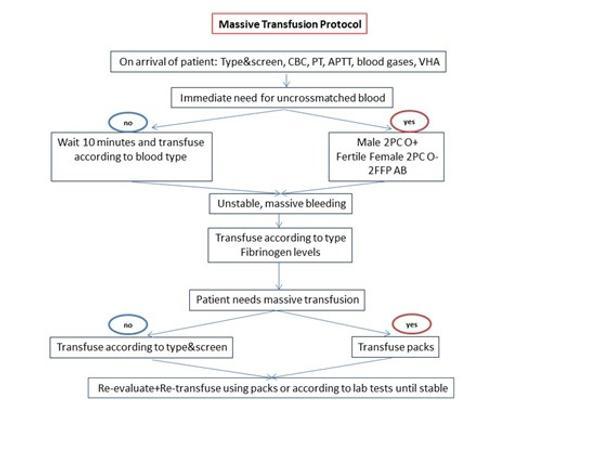Key points:
- Definitions
- Rational for massive transfusion protocol
- Background
- A suggested framework for massive transfusion protocol
Definitions
Massive bleeding is defined as the loss of more than one blood volume within 24 hours (h), 50% of the patient's total blood volume lost in less than 3h or bleeding in excess of 150ml/minute[1]. Postpartum hemorrhage is defined as blood loss greater than 1000ml of blood and continuing to bleed[2]. Massive transfusion is defined as receipt of ≥10 units of packed red blood cells (RBC) in 24h (10/24), ≥6 units of RBC in 6h (6/6)and ≥5 units of RBC in 4h (5/4)[3].
Why do we need a tool to manage massive transfusion?
Like any emergency and overwhelming situation in which a rapid response is in demand, preparedness of the blood bank with standard operating procedures and a massive transfusion protocol (MTP) enables an effective response and increases the chance to salvage patients. Major hemorrhage is associated with a high mortality rate, there are an estimated 30,000 yearly preventable civilian deaths in the USA secondary to hemorrhage caused by trauma, 25,000 of them in the prehospital phase of resuscitation and the remainder in-hospital[4]. Trauma is associated with a high incidence of early trauma-induced coagulopathy which necessitates prompt management with appropriate blood component replacement[5]. Practically the surgical team is concentrated on the mission of stopping the bleeding and the anesthesiology team is concentrated on keeping the patient oxygenated and perfused. One could compare the situation to an aviation team trying to land an aircraft safely under extreme weather conditions. The blood bank and transfusion service can proactively calculate how many blood products were transfused, check the laboratory results and advise the treating team regarding the recommended blood products, as the air traffic control tower advises and helps the aviation team. The MTP provides a framework for transfusing the patient effectively.
Background
MTPs have been in use for over a decade. The US army recommended transfusion of plasma(FFP):(RBC) ratio 1:1 based on data from patients admitted to a combat support hospital in Iraq between 2003-2005[6]. The PROPPR trial, a large, randomized controlled trial conducted in traumatically injured patients with major bleeding, compared a ratio of 1:1:1 to 1:1:2 (FFP:PLT:RBC) and did not find significant differences in mortality at 24h at 30 days, although there was reduced death from hemorrhage at 24 h [7]. There is a European guideline for the management of major bleeding and coagulopathy following trauma, and the 4th edition was published in 2016[8]. According to this guideline a trauma center should have a local multidisciplinary, evidence based treatment algorithm or clinical management guideline for the bleeding trauma patient, thus enabling cooperation and harmonized treatment. The algorithm should include initial resuscitation upon arrival of the patient to the hospital by administering blood components at a fixed ratio and the ongoing management of bleeding utilizing traditional laboratory testing and viscoelastic hemostatic assays (VHA) such as thromboelastography.
Massive Transfusion Protocols
Coagulopathy induced by trauma and massive bleeding worsens the outcome of trauma patients and therefore should be minimalized [5][13][14]. During rapid bleeding there is no time to wait for the laboratory test results to arrive (usually 45-60 minutes), because by the time they are released they may be irrelevant. For this reason, the protocol contains FFP upfront from the first pack and in all subsequent packs. The number of components in each pack is determined in each hospital according to the physical distance of the blood bank from the trauma bay and operating theater. When the distance is short, a smaller pack can be supplied, however, when the blood bank is not located in proximity to the trauma bay, larger packs should be used.
Concomitantly laboratory tests including complete blood count (CBC), prothrombin time (PT), activated partial thromboplastin time (APTT) and fibrinogen should be performed, as well as viscoelastic hemostatic assays (VHA) such as thromboelstography. Once laboratory results are available, goal directed therapy can replace the fixed packs program.
When the platelet count is less than 100,000/ul, platelets should be given. If fibrinogen levels drop to less than 200mg/ml, cryoprecipitate or fibrinogen concentrate 25mg/kg-50mg/kg 2-4 grams for adults of 80 kg should be administered [8][15]. Cryoprecipitate is used more commonly in the USA, fibrinogen concentrate in Europe. Trauma is accompanied by fibrinolysis and tranexamic acid should be added. Its benefit was demonstrated both in trauma and in postpartum hemorrhage, and in both cases increased D-Dimers are observed[16] [17][18]. When the patient is stabilized, the MTP can be terminated.
Post-Partum Hemorrhage:
Postpartum hemorrhage is associated with a rapid decline of fibrinogen due to consumption. While the typical fibrinogen level in an adult male is 150-250 mg/dl, the level of fibrinogen in a woman in the third trimester of pregnancy is 400-600 mg/dl. Enhanced replacement of fibrinogen should be initiated from the first pack and augmentation of the dosage to 20 units of cryoprecipitate or 2-4 gm fibrinogen is common based on laboratory results. The use of fibrinogen concentrates instead of fibrinogen in post-partum hemorrhage is still being studied, to date rigorous studies comparing cryoprecipitate and fibrinogen concentrates in major obstetric hemorrhage are lacking [19].
Pediatric MTP is not discussed here however it is desirable that blood banks have a pediatric MTP as well.
Summary
MTPs are useful tools to provide a balanced blood product supply in a short time. Since successful treatment depends on teamwork, transfusion specialists and blood bank laboratory directors should be actively involved in planning institutional protocols and transfusion medicine specialists should be notified during such an event.
References
1. Norfolk D, editor. Handbook of Transfusion Medicine, ed 5. United Kingdom Blood Services, TSO.
2. Mavrides E, Allard S, Chandraharan E et al, on behalf of the RC of O and G. Prevention and Management of Postpartum Haemorrhage. BJOG. 2016;16;124(5):e106–49.
3. Zatta AJ, Mcquilten ZK, Mitra B, et al. Elucidating the clinical characteristics of patients captured using different definitions of massive transfusion. Vox Sang. 2014;107(1):60–70.
4. Yazer MH, Cap AP, Spinella PC et al. How do I implement a whole blood program for massively bleeding patients? Transfusion. 2018;58(3):622–8.
5. Brohi K, Singh J, Heron M et al. Acute Traumatic Coagulopathy. J Trauma. 2003;54(6).
6. Borgman MA, Spinella PC, Perkins JG et al. The ratio of blood products transfused affects mortality in patients receiving massive transfusions at a combat support hospital. J Trauma. 2007; 63:803-15.
7. Holcomb JB, Tilley BC, Baraniuk S et al. Transfusion of plasma, platelets, and red blood cells in a 1:1:1 vs a 1:1:2 ratio and mortality in patients with severe trauma: The PROPPR randomized clinical trial. JAMA .2015;313(5):471–82.
8. Rossaint R, Bouillon B, Cerny V et al. The European guideline on management of major bleeding and coagulopathy following trauma: Fourth edition. Crit Care. 2016;20: 100.
9. Hunt BJ, Allard S, Keeling D et al. A practical guideline for the haematological management of major haemorrhage. Br J Haematol. 2015; 170(6):788-803.
10. Schäfer N, Driessen A, Fröhlich M et al. Diversity in clinical management and protocols for the treatment of major bleeding trauma patients across European level I Trauma Centres. Scand J Trauma Resusc Emerg Med. 2015; 23:74.
11. Seheult JN, Bahr M, Anto V et al. Safety profile of uncrossmatched, cold-stored, low-titer, group O+ whole blood in civilian trauma patients. Transfusion 2018;58:2280–8.
12. Cotton BA, Gunter OL, Isbell J et al. Damage control hematology: The impact of a trauma exsanguination protocol on survival and blood product utilization. J Trauma. 2008; 64(5):1177-82.
13. MacLeod JBA, Lynn M, McKenney MG et al. Early Coagulopathy Predicts Mortality in Trauma. J Trauma. 2003;55(1):39-44.
14. Dann EJ, Michaelson M, Barzelay M et al. Transfusion medicine during the summer of 2006: lessons learned in northern Israel. Transfus Med Rev. 2008; 22(1):70–6.
15. Levy JH, Goodnough LT. How I use fibrinogen replacement therapy in acquired bleeding. Blood. 2015;125(9):1387–93.
16. Shakur H, Roberts I, Bautista R et al. Effects of tranexamic acid on death, vascular occlusive events, and blood transfusion in trauma patients with significant haemorrhage (CRASH-2): a randomised, placebo-controlled trial. Lancet. 2010;376:23–32.
17. Ducloy-Bouthors AS, Duhamel A, Kipnis E et al. Postpartum haemorrhage related early increase in D-dimers is inhibited by tranexamic acid: haemostasis parameters of a randomized controlled open labelled trial. Br J Anaesth. 2016;116(5):641–8.
18. Sentilhes L, Lasocki S, Ducloy-Bouthors AS et al. Tranexamic acid for the prevention and treatment of postpartum haemorrhage. Br J Anaesth. 2015;114(4):576–87.
19. O’Brien KL, Shainker SA, Lockhart EL. Transfusion Management of Obstetric Hemorrhage. Transfus Med Rev. 2018; 32(4):249-255.
Suggested Reading List: References 4, 8 and 9.
The authors


















